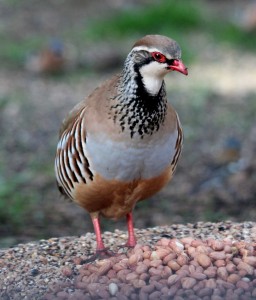 Last week a reader contacted me about some exotic birds she had seen and they were feeding in her large garden. She correctly identified them as red-legged partridges but wondered what they were doing there, where they had come from and how common they were in the Highlands. As you can see from the photograph I took in my garden they are indeed very exotic looking birds. By co-incidence I saw a group of them crossing the road last week just south of Inverness and they scurried across, eleven in the covey as a group are called. Their rapid running is a feature of this bird as they are often reluctant to fly. In size the red-legged partridge is larger than a grey partridge but smaller than a pheasant and the plain grey-brown upperparts contrast with rest of the plumage. One conspicuous feature is the boldly striped black, white and chestnut flanks with the white chin and throat bordered with black. These black dotted feathers look just like a necklace on the bluish breast. The beak and feet are a vivid red and the male and female look the same, although the female is slightly smaller than the male.
Last week a reader contacted me about some exotic birds she had seen and they were feeding in her large garden. She correctly identified them as red-legged partridges but wondered what they were doing there, where they had come from and how common they were in the Highlands. As you can see from the photograph I took in my garden they are indeed very exotic looking birds. By co-incidence I saw a group of them crossing the road last week just south of Inverness and they scurried across, eleven in the covey as a group are called. Their rapid running is a feature of this bird as they are often reluctant to fly. In size the red-legged partridge is larger than a grey partridge but smaller than a pheasant and the plain grey-brown upperparts contrast with rest of the plumage. One conspicuous feature is the boldly striped black, white and chestnut flanks with the white chin and throat bordered with black. These black dotted feathers look just like a necklace on the bluish breast. The beak and feet are a vivid red and the male and female look the same, although the female is slightly smaller than the male.
As with pheasants, these game birds are not native and the red-legged partridge was deliberately introduced into southern Britain, as a gamebird, as far back as 1673 and again in 1770 in Scotland. These early releases were not successful but from 1963 commercial rearing became more widespread and huge numbers of birds were, and are, involved. It is difficult to a appreciate the sheer numbers released each year but the latest estimate give the overall figure for game birds. These are the pheasant and red-legged partridge and the figure for the UK is around 35 million – yes, 35 million birds each year. All these are put down for commercial and local shooting. Around 20% of this total are red-legged partridges and some wander away from such shoots or are not shot and so we end up each year with a few that breed although outside the shooting areas these are few and far between. Whatever you think of shooting and the rearing of so many birds for shooting on large estates and the very many small shoots, it is a multi-million pound business that affects many lives in terms of direct employment and spin-offs.
The latest Highland Bird Report 2013 says of the red-legged partridge that it is “Released annually in very high numbers by main commercial shooting estates and then can be found quite widely dispersed, scarce elsewhere”. The population in Scotland depends on the numbers release each year. The basic breeding numbers is probably around 500 pairs. In the breeding season, starting in April or May, the male makes several shallow scrapes on the ground and the female chooses which one to lay her 10-16 eggs. Many pairs produce a second clutch that is incubated simultaneously by the male. The incubation lasts about 23 days and the young are able to fly from 10 days. Interestingly, if only one clutch is laid both male and female then rear the family but if there are two clutches then they split with the female looking after one brood and the male the other. However, eventually both form groups and then, with others, can form coveys of over forty birds although up to a dozen is more normal. The Scottish birds are resident and seldom move more than a few kilometres from where they were hatched or released as adults or young birds. As with many other ground nesting birds predation is high and can come from a range of birds from buzzards to crows and mammals from foxes to stoats.
Tags: highland birds
